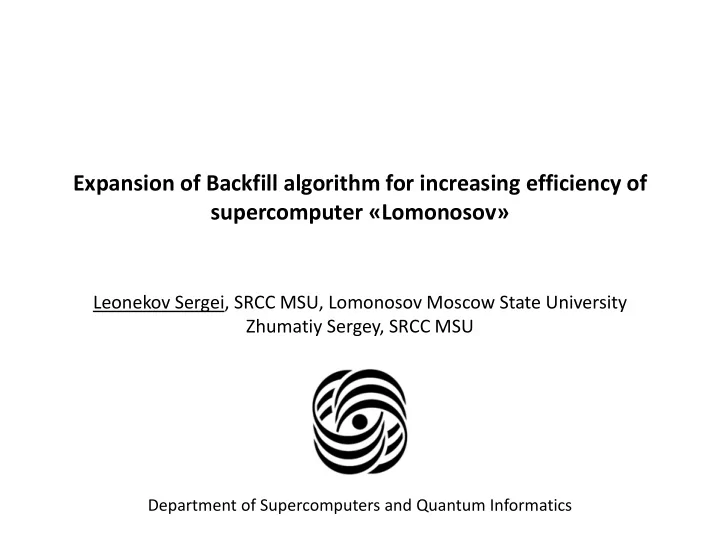

Expansion of Backfill algorithm for increasing efficiency of supercomputer « Lomonosov » Leonekov Sergei, SRCC MSU, Lomonosov Moscow State University Zhumatiy Sergey, SRCC MSU Department of Supercomputers and Quantum Informatics
SLURM SLURM is a scalable, fault-tolerant cluster manager and scheduler for large computing systems. It is considered to be the most prospective resource manager. * SLURM (v2.5.6) is used on supercomputer "Lomonosov". SLURM (v15.08) is used on supercomputer "Lomonosov-2". (*) Javier Cacheiro, Pablo Rey, Alvaro Simón,“Batch System Comparison Technical Report V4”, Cesga, 13/02/2014 1
Backfill Scheduling algorithm Backfill is algorithm First Come First Served upgraded with "packing". This scheduling algorithm is used in a large number of clusters and proved to be highly effective. Studies have shown that the algorithm can improve density of use of the supercomputers resources by ~ 20% and reduce the average waiting time for setting goals for performance. (*) (CPUs) (time) (CPUs) (time) 2 (*) David Jackson, Quinn Snell, Mark Clement “Core Algorithms of the Maui Scheduler”, Brigham Young University, Provo, Utah
Backfill example 3
MSU SRCC Supercomputer "Lomonosov" is ranked in the 2 nd place in the Top50; - - has more than 400 "active" accounts during a year; - runs 200-400 tasks every day. Supercomputer "Lomonosov-2" is ranked in the 36 th place in the TOP500. If the priority “transparency” of each individual task is increased it will be able to use SLURM more intelligently. Queue Regular4 Priority = 4294901717 4
Development goals The main goals are ● To increase number of the users resourced at any time, "transparency" of priorities and ease of administration tasks queue using resource manager SLURM; ● To develop a planner with all of the features on the basis of SLURM. Slurmctld System main agent Interface wiki2 External scheduler New external plugin 5
External scheduler architecture Types of SLURM/wiki2 messages: CANCELJOB, GETJOBS, JOBMODIFY, NOTIFYJOB, STARTJOB, INITIALIZE, REQUEUEJOB, SUSPENDJOB, RESUMEJOB, SIGNALJOB. Two types of SLURM/wiki2 events: tasks state change AND slurmctld status change. Slurmctld System main agent Interface wiki2 External scheduler New external plugin 6
SLURM optimizations New external scheduler functionality includes all the features of the built-in Backfill planning algorithm and introduces several new features: 1. The number of processor-hours requested by each user is taken into account; 2. There is a transparent priority system that can be adjusted in real time; 3. Users with a certain level of priority can use nodes from different sections; 4. Various time quotas can be set: a certain number of CPU hours per week/month/year; 5. Different planning algorithms can be used in different queues; Experiments Data (Acceleration) Delay (user) Delay (job) (nodes) Backfill 0,998 1 Backfill + CPU-h 1 0,907 limit (time) 7
“Transparency” of priorities ● Multifactor plugin: Job_priority = (PriorityWeightAge) * (age_factor) + (PriorityWeightFairshare) * (fairshare_factor) + (PriorityWeightJobSize) * (job_size_factor) + (PriorityWeightPartition) * (partition_factor) + (PriorityWeightQOS) * (QOS_factor); // Priority = 4294901717 “Transparency”: ● takes a single limited scale for all users; ● uses data of every year users survey; ● uses “year work mark” weight; ● arranges priorities by special groups (students, university scientists and so on). 8
Scalable external scheduler The solution is easily expandable thanks to its software primitives and completeness of the information that external scheduler receive from SLURM. Priority system can be adjusted in real time. New scheduling algorithm can be added without making any changes in SLURM core functions and plugins. Moreover, external scheduler interface is standardized and simplified as much as possible, making it easy to add and edit a new scheduling techniques. Data: Output: ● job info ● modified queue ● queue info state after each ● SLURM state step of external ● сluster state scheduling ... 9
New Backfill-based algorithm “Acceleration” on each step: Standard scheduler cycle (single partition example) looks like: 1. Create a queue for the partition; 2. Sort tasks by priority; 3. Remove tasks (which is not startable) (CPU-limit); 4. Load data from "Acceleration" table; 5. "Accelerate" jobs from the table to the specified number of positions; 6. Find nodes for running jobs; 7. "Pack", if required; “Boost” operation: 8. Run tasks; 9. Update queue and node statuses and "Acceleration" table; 10. Return to Step 2. “Acceleration” table example: JobID User Speed Count SpeedUp 1242 stud 0.3 0 2 ... ... ... ... ... ... ... ... ... ... 10
Conclusion An external scheduler was implemented: ● based on SLURM primitives; ● scalable; ● portable; ● different planning algorithms can be used in different queues; ● simplified priority system; The implemented system was tested on both “Lomonosov” and “Lomonosov - 2” and ready for deployment. 11
Thank you for your attention! Leonenkov Sergei Lomonosov Moscow State University Scientific Research Computing Centre leonenkovs@gmail.com
Publications and presentations: 1. S. N. Leonenkov, S. A. Zhumatiy "Expanding the functionality of SLURM resource manager", XVI International Supercomputer Conference "Scientific service in the Internet: A variety of supercomputing worlds", 9/26/2014. 2. Poster presentation at the conference "Parallel Computing Technologies (PaVT) 2015", 01/04/2015. 3. S. N. Leonenkov, S. A. Zhumatiy “Introducing new backfill -based scheduler for SLURM resource manager”, YSC -2015, Greece Leonenkov Sergey Lomonosov Moscow State University Scientific Research Computing Centre leonenkovs@gmail.com
Recommend
More recommend